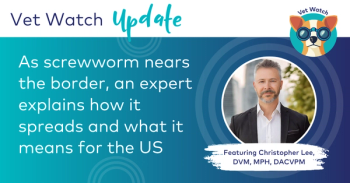
A challenging case: A dog with ocular masses
A middle-aged 48.5-lb (22-kg) spayed female Border collie mix was presented to the Colorado State University Veterinary Teaching Hospital for evaluation of a red, weepy left eye.
A middle-aged 48.5-lb (22-kg) spayed female Border collie mix was presented to the Colorado State University Veterinary Teaching Hospital for evaluation of a red, weepy left eye. At presentation, the dog was bright, alert, and active.
Vital Stats
History
Three months before presentation, an ophthalmologist had evaluated the dog because of a tissue mass on the temporal conjunctiva of its left eye. The dog also had a laceration of the nictitating membrane, so the ophthalmologist suspected that the mass was scar tissue related to trauma. The ophthalmologist recommended a surgical biopsy, but the owners declined it.
Two months after the evaluation, the left eye exhibited redness and discharge, so the owners had presented the dog to its regular veterinarian. The dog was treated for unilateral conjunctivitis with a topical antibiotic ophthalmic ointment twice daily in the left eye. The redness decreased for a few days, but the eye then became painful and more inflamed. The dog was brought to the Colorado State University Veterinary Teaching Hospital because the owners were vacationing in Colorado when the ocular signs worsened.
Other pertinent history findings included that the dog had been a stray in Mexico before the owners adopted it, so the dog's age and breed were unknown. At that time, the dog had a right coxofemoral luxation that had been repaired soon after. The dog had traveled across the western United States and lived in California. The dog's vaccination status was current, and it was receiving topical flea and tick preventive medication.
Physical and ocular examinations
The results of the physical examination were normal except for the left eye. The conjunctiva and episclera were markedly hyperemic, especially temporally, and moderate chemosis, copious mucoid discharge, and blepharospasm were present. A large (6 mm diameter), immobile subconjunctival mass was present at the lateral limbal area that extended temporally. When digitally palpated, the mass felt mildly fluctuant and did not seem to extend behind the globe; however, our palpation was cursory because the mass was causing considerable pain. Retropulsion of the globe was normal, and opening the dog's mouth elicited no pain. The nictitating membrane had a healed laceration along its margin that manifested as a free flap that began at the temporal portion of the horizontal T-shaped cartilage and extended 3 to 4 mm nasally and 2 mm ventrally. The flap did not appear to be causing any problems and was in a distinct location from the subconjunctival mass. Intraocular pressure was 7 mm Hg in the left eye and 15 mm Hg in the right eye (normal = 15 to 25 mm Hg). The results of the remainder of the ocular examination were normal in both eyes.
Although a biopsy of the mass was highly recommended to the owners, they again elected medical therapy. Cytologic evaluation of a conjunctival scraping showed an infiltrate of neutrophils, lymphocytes (few), and plasma cells. The dog received a topical neomycin-polymyxin B-dexamethasone ointment in the left eye every eight hours and amoxicillin trihydrate-clavulanate potassium (13.5 mg/kg) orally twice daily. The dog's ocular signs improved only slightly with this therapy, so the dog was presented to us again two weeks later.
Additional tests
Because of the continuing inflammation in the left eye, we suspected that the mass was not scar tissue and again recommended further diagnostic tests. Topical proparacaine was given, and a conjunctival scraping was done. The cytologic evaluation revealed numerous degenerated neutrophils and eosinophils but no bacterial or fungal organisms. Because of the cytologic examination results, we suspected an infectious or parasitic process. Other differential diagnoses included immune-mediated and neoplastic diseases and a foreign body (e.g. cat claw). An excisional biopsy was recommended because it could provide a diagnosis and might also be curative, as it could remove the entire lesion. The dog's surgery was scheduled for the next day.
The results of the presurgical blood work (complete blood count and serum chemistry profile) were normal except for a mature lymphocytosis (7.2 × 103/µl; normal = 1 to 4.8 × 103/µl) and an eosinophilia (2.4 × 103/µl; normal = 0.1 to 1.2 × 103/µl). Preoperative medications included atropine (0.04 mg/kg), acepromazine (0.01 mg/kg), and morphine (1 mg/kg) subcutaneously. Anesthesia was induced with thiopental intravenously and maintained with isoflurane inhalation anesthesia. In preparation for surgery, we flushed the eye with dilute povidone-iodine solution (1:50).
We used an eyelid speculum to open the palpebral fissure and used tenotomy scissors to incise the conjunctiva over the mass. We then used the scissors to dissect through the tissues surrounding the mass. The mass seemed separate from the underlying sclera but involved Tenon's capsule. We removed all apparently affected tissue. The mass seemed to peel out well, although there was no distinct capsule. Two other nodules were adjacent to the gland of the nictitating membrane on the bulbar conjunctiva. Three threadlike worms were adhered to these nodules but broke off as they were being extracted with Bishop-Harmon thumb forceps (Figure 1). We also excised these nodules with tenotomy scissors and placed all excised tissues in formalin and submitted them for histopathologic evaluation. Simple interrupted sutures of 7-0 polyglycolic acid were used to close the conjunctiva, and all the knots were buried. We also evaluated the right eye for small nodules; none were found.
Figure 1: Surgical removal of a subconjunctival mass in a dog (not the dog in this case report) with ocular onchocerciasis. The conjunctiva has been incised to help identify the type of parasite; the surgeon is removing a threadlike worm from the mass. Photo courtesy of Dr. David Williams.
The dog's recovery from anesthesia was uneventful. The dog was discharged from the hospital, and the owners were instructed to administer topical neomycin-polymyxin B-dexamethasone ointment in the left eye every eight hours. A follow-up examination was scheduled for seven days later.
Diagnosis and treatment
The results of the initial histopathologic examination of the masses suggested that the parasite was a Thelazia species. Two days later, after consulting with a parasitologist, the diagnosis was changed to a parasitic episcleral mass due to Onchocerca species. The submitted sample consisted of loose, vascular connective tissue surrounding a moderately well-demarcated, multilobular granulomatous mass containing numerous nematode cross sections and free microfilariae (Figures 2 & 3). The nematode intestines were uniformly small, and gravid females contained both microfilariae and ova within the uteri (Figure 2). The nematodes had thick cuticles with regularly spaced cuticular ridges overlying dorsal and ventral bands of coelomyarian somatic musculature separated by elongated and flattened lateral cords (Figure 4); these features are characteristic of Onchocerca species.1,2
Figure 2 : A granulomatous mass containing numerous nematode cross sections (40X). The inset shows microfilariae (arrow) within a section of uterus (hematoxylin-eosin stain; 100X).
After obtaining the results of the first histologic evaluation (i.e. the worm was Thelazia species), we treated the dog with topical ivermectin using the injectable formulation (10 mg/ml; 1 drop in the left eye twice weekly for six weeks).3 We gave the injectable product because its pH was compatible with ophthalmic use. We chose topical therapy over systemic therapy because this dog was a Border collie mix and we were concerned about systemic toxicity.4 A six-week course of therapy was directed at killing the Thelazia species microfilariae based on their prepatent periods and the susceptibility of the larvae at different stages of development.3 To control the inflammation that would accompany parasite death, we treated the dog with prednisone (5 mg orally b.i.d.). We prescribed amoxicillin trihydrate-clavulanate potassium (250 mg orally b.i.d.) for 14 days and continued the topical neomycin-polymyxin B-dexamethasone ointment for a minimum of 14 days.
Figure 3 : Microfilariae (arrows) free within the granulomatous tissue of the mass (hematoxylin-eosin stain; 100X).
Follow-up
The dog returned to California before the definitive diagnosis of onchocerciasis was made, so follow-up examinations were with the original ophthalmologist. Two weeks after the surgery, the surgical site had healed well, and the owners were instructed to continue the topical neomycin-polymyxin B-dexamethasone ointment and ivermectin as instructed by us.
When onchocerciasis was definitively diagnosed, melarsomine (2.5 mg/kg every 24 hours for two days) was administered as an adulticide for this nematode. Subcutaneous ivermectin (50 µg/kg) was added one month later.5
One month after receiving melarsomine therapy, the dog developed a golf ball-sized swelling below the left eye and was treated with carprofen (2.2 mg/kg b.i.d. for seven days). The swelling resolved three days after beginning the anti-inflammatory therapy. At follow-up examinations, the dog continued to have moderate eyelid swelling that was suspected to be due to the death of the worms. However, the dog was fairly comfortable, and no masses recurred.
Figure 4 : The left image shows thick cuticle overlying prominent bands of coelomyarian musculature (large arrowhead) separated by thin lateral cords (small arrowheads) around two large ovoid uteri containing ova and a small cross section of intestine (small arrow) (hematoxylin-eosin stain; 100X). The right image shows prominent, regularly spaced cuticular ridges (arrows) over the external surface of the cuticle, characteristic of Onchocerca species (hematoxylin-eosin stain; 400X).
Discussion
Onchocercosis is a disease caused by infection with various species of filarial nematodes of the genus Onchocerca. Although more commonly seen in horses and ungulates, it has been reported in dogs worldwide. Onchocerca species have also been incriminated as a factor in the disease in people known as river blindness, which affects more than 17 million people worldwide and in 1993 caused vision loss in 270,000 people.6
Onchocerca species microfilariae, like other filarial worms, are transmitted by insect intermediate hosts, specifically gnats (Culicoides species) or black flies (Simulium species). The microfilariae are transmitted to a mammalian host while the insect is feeding; the microfilariae then migrate to specific sites in the host's body, most commonly to the skin and the ocular subconjunctiva and conjunctiva. In these sites, the microfilariae mature, mate, and release more microfilariae that circulate in the blood of the mammal and infect another blood-feeding insect when it feeds. In horses, the adults often inhabit the nuchal ligament.
Microfilariae form microfilarial nodules in the deep subcutaneous tissues and ligaments of large mammals, but in the eye, microfilariae may cause conjunctivitis, conjunctival depigmentation, uveitis, and keratitis (Figures 5 & 6). Microfilariae may also lead to exophthalmos due to retrobulbar granulomas.
Figure 5 : A dog (not the dog in this case report) with ocular onchocerciasis. The right eye exhibits hyperemic conjunctiva overlying a mass at the temporal limbal area. Moderate chemosis is also present. Photo courtesy of Dr. David Williams.
New research into river blindness strongly suggests that the disease is caused largely by the host's reaction to the microfilariae's endosymbiotic bacteria Wolbachia species rather than to the Onchocerca species microfilariae themselves.7 This research has important implications for the treatment of this disease because the nematodes need these bacteria to reproduce. Killing the bacteria with antibiotics interrupts the parasite's life cycle.8 Experimentally, extracts of Wolbachia species proteins cause significantly more ocular damage than extracts of Onchocerca species microfilariae alone cause.9 Tetracyclines are effective against Wolbachia species.9
Figure 6 : A dog (not the dog in this case report) with severe ocular onchocerciasis. The right eye has two subconjunctival masses, severe conjunctival hyperemia, and corneal edema and neovascularization. Photo courtesy of Dr. David Williams.
Ocular lesions may be the only clinical signs in dogs infected with this parasite. Canine ocular onchocerciasis has been identified worldwide. Forty-three cases were reported in Greece,5,10 five in Hungary,11,12 and seven in the United States.13-16 The morphologies of the parasites obtained from the ocular tissue samples from dogs from all these countries were similar, and it was thought that these parasites were all the same species.10,13,14,16,17 To confirm this, polymerase chain reaction was used to amplify the cytochrome oxidase gene from the microfilariae and the 16S ribosomal RNA gene from their Wolbachia endosymbiont. These gene sequences were identified and compared, and they appeared to be identical to the Onchocerca species isolated from the dogs in Greece and Hungary.10 The exact Onchocerca species infecting the eyes of dogs is under debate, but a recent study suggested that it is not an aberrant infection with Onchocerca lienalis (the parasite that infects cattle) but is Onchocerca lupi, a species first discovered in a wolf's eye.12,17,18 Other investigators think that, based on parasite morphology and geographic distribution, O. lienalis is most likely the species that infects dogs in the United States.16
Clinical signs of ocular onchocerciasis in dogs include periorbital swelling, exophthalmos, lacrimation, photophobia, conjunctival congestion, corneal edema, protrusion of the nictitating membrane, and subconjunctival granuloma or cyst formation.5,10 The mass lesions may be single or multiple.10 The results of complete blood counts and serum chemistry profiles of affected dogs may be normal or, as in the dog presented here, may reveal an absolute eosinophilia.10
Diagnosing ocular onchocerciasis in dogs is based on clinical signs and a history of travel to the western United States, Hungary, or Greece, where the disease is most commonly found. Interestingly, in the reported cases, German shepherds are over-represented.5 A definitive diagnosis of the disease is based on a histopathologic evaluation of the subconjunctival masses formed by the worms.15 These parasites induce an intense proliferative pyogranulomatous inflammation surrounding the nematodes.15 The Onchocerca species nematode is identified by its thick, multilayered cuticle and circumferential external ridges. It also possesses prominent hypodermal tissue between the cuticle and muscles.12,15
The mainstay of treatment for ocular onchocerciasis in dogs is the complete removal of the nematode and inflammatory masses and a follow-up anthelmintic protocol.5 In one study, researchers treated 23 reported cases with postoperative systemic and topical antibiotics for nine days after surgery.5 To achieve complete removal of possible remaining parasites, systemic anthelmintic treatment was begun on the ninth day after surgery. This treatment consisted of melarsomine (2.5 mg/kg intramuscularly) given once a day for two days and ivermectin (50 µg/kg subcutaneously) given once one month after that.5 The dogs had marked edema of the periorbital tissues after melarsomine therapy, but the edema resolved in seven days. Lesions did not recur in any of the dogs after this protocol.5
Although uncommon, more and more cases of canine ocular onchocerciasis are being reported worldwide, especially in the western United States.15 Recent increases in the number of diagnosed cases in the United States may be due to an increased awareness of the disease, to increased exposure of dogs to an aberrant form of the disease that affects cattle, or to the establishment of a previously unidentified canine-specific species in the affected areas.10,11,15,17 Ocular onchocerciasis should be included in the differential diagnoses of subconjunctival masses, particularly in dogs that have been in California or Nevada or in Hungary or Greece. The prognosis appears to be good with appropriate therapy, and complete resolution is likely.
Juliet R. Gionfriddo, DVM, MS, DACVO
Brendan Mangan, DVM, MS
Department of Clinical Sciences
Greg Wilkerson, DVM
Department of Microbiology, Immunology, and Pathology
Cynthia C. Powell, DVM, MS, DACVO
Department of Clinical Sciences
College of Veterinary Medicine and Biomedical Sciences
Colorado State University
Fort Collins, CO 80523
Deborah S. Friedman, DVM, DACVO
Animal Eye Care
1612 Washington Blvd.
Fremont, CA 94539
E.J. Ehrhart, DVM, PhD, DACVP
Department of Microbiology, Immunology, and Pathology
College of Veterinary Medicine and Biomedical Sciences
Colorado State University
Fort Collins, CO 80523
REFERENCES
1. Chitwood M, Lichtenfels JR. Identification of parasitic metazoan in tissue sections. USDA. Beltsville, Md 1973.
2. World Health organization. Onchocerciasis (river blindness). Fact Sheet. No. 59 1990.
3. Lia RP, Traversa D, Agostini A, et al. Field efficacy of moxidectin 1 per cent against Thelazia callipaeda naturally infected dogs. Vet Rec 2004;154:143-145.
4. Paul AJ, Tranquilli WJ, Seward RL, et al. Clinical observations in collies given ivermectin orally. Am J Vet Res 1987;48:684-685.
5. Komnenou A, Eberhard ML, Kaldrymidou E, et al. Subconjunctival filariasis due to Onchocerca sp. in dogs: report of 23 cases in Greece. Vet Ophthalmol 2002;5:119-126.
6. Lazdins-Helds JK, Remme JH, Boakye B. Onchocerciasis. Nat Rev Microbiol 2003;1:178-179.
7. Taylor MJ. Wolbachia in the inflammatory pathogenesis of human filariasis. Ann NY Acad Sci 2003;990:444-449.
8. Hoerauf A, Adjei O, Buttner DW. Antibiotics for the treatment of onchocerciasis and other filarial infections. Curr Opin Investig Drugs 2002;3:533-537.
9. Pearlman E, Hall LR. Immune mechanisms in Onchocerca volvulus-mediated corneal disease (river blindness). Parasite Immunol 2000;22:625-631.
10. Komnenou A, Egyed Z, Sreter T, et al. Canine onchocercosis in Greece: report of further 20 cases and molecular characterization of the parasite and its Wolbachia endosymbiont. Vet Parasitol 2003;118:151-155.
11. Szell Z, Erdelyi I, Sreter T, et al. Canine ocular onchocercosis in Hungary. Vet Parasitol 2001;97:243-249.
12. Szell Z, Sreter T, Erdelyi I, et al. Ocular onchocercosis in dogs: aberrant infection in an accidental host or lupi onchocercosis? Vet Parasitol 2001;101:115-125.
13. Orihel TC, Ash LR, Holshuh HJ, et al. Onchocerciasis in a California dog. Am J Trop Med Hyg 1991;44:513-517.
14. Gardiner CH, Dick EJ Jr, Meininger AC, et al. Onchocerciasis in two dogs. J Am Vet Med Assoc 1993;203:828-830.
15. Zarfoss MK, Dubielzig RR, Eberhard ML, et al. Canine ocular onchocerciasis in the United States: two new cases and a review of the literature. Vet Ophthalmol 2005;8:51-57.
16. Eberhard ML, Ortega Y, Dial S, et al. Ocular Onchocerca infections in two dogs in the western United States. Vet Parasitol 2000;90:333-338.
17. Egyed Z, Sreter T, Szell Z, et al. Morphologic and genetic characterization of Onchocerca lupi infecting dogs. Vet Parasitol 2001;102:309-319.
18. Rodonaja TE. A new species of nematode, Onchocerca lupi sp. N. from Canis lupuscubanensis. Soobshcheniya Akademii Nayk Gruzinksaya SSR 1967;45:715-719, as cited In: Egyed Z, Sreter T, Szell Z, et al. Morphologic and genetic characterization of Onchocerca lupi infecting dogs. Vet Parasitol 2001;102:309-319.
Newsletter
From exam room tips to practice management insights, get trusted veterinary news delivered straight to your inbox—subscribe to dvm360.






